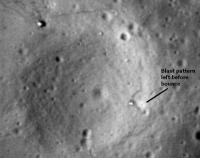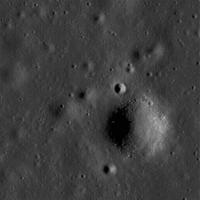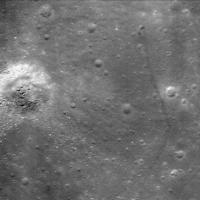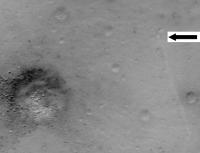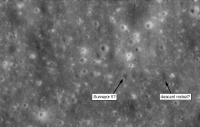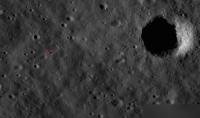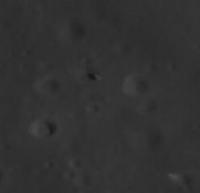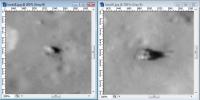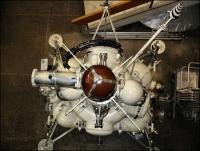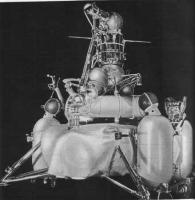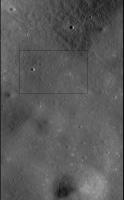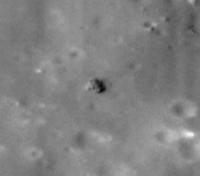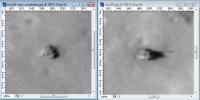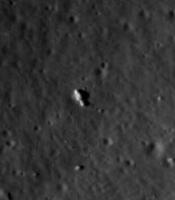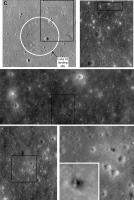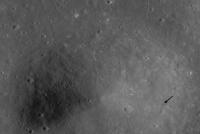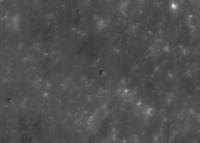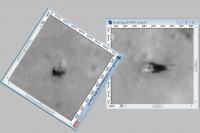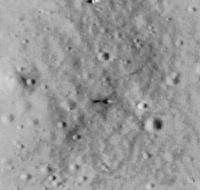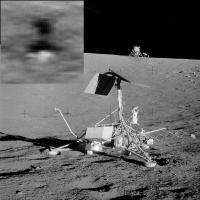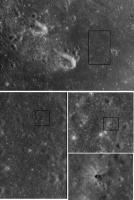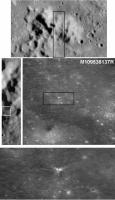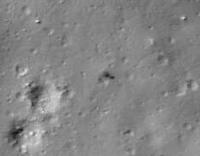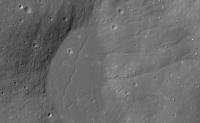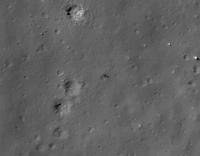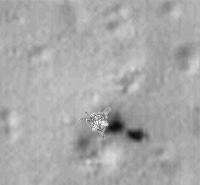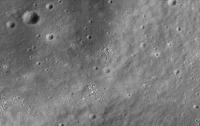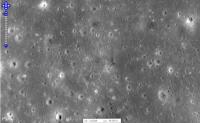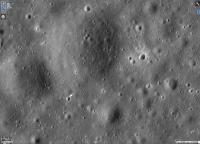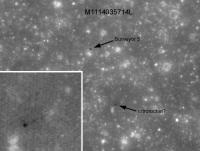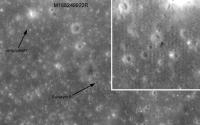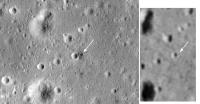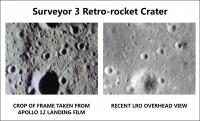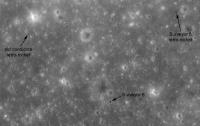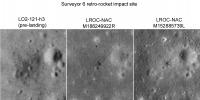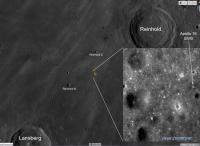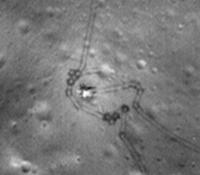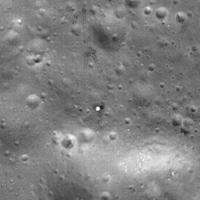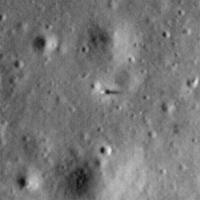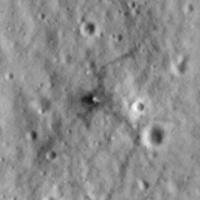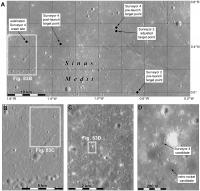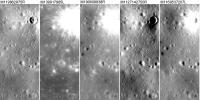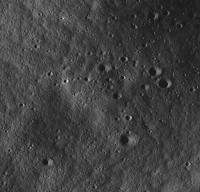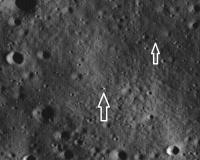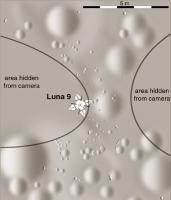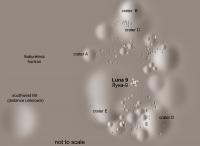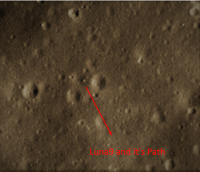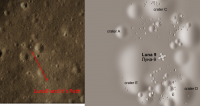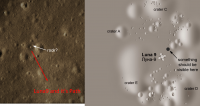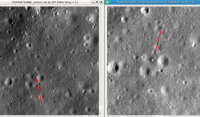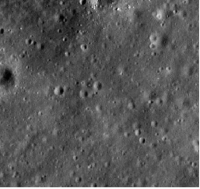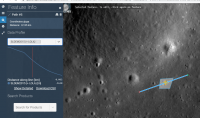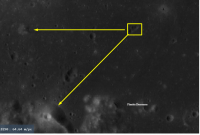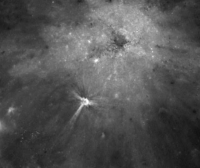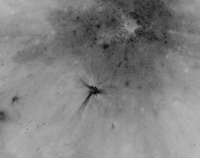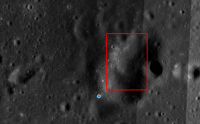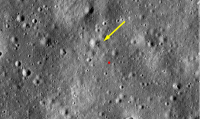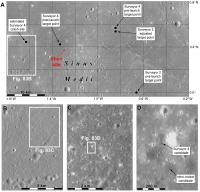Printable Version of Topic
Click here to view this topic in its original format
Unmanned Spaceflight.com _ LRO & LCROSS _ Unmanned landing sites from LRO
Posted by: dvandorn Sep 7 2009, 07:51 PM
I figured it was time to begin a thread like this, especially since some of us may still be looking for the Surveyor III retro motor casing (assuming the bright dot to the north of the landing site isn't it).
We ought to be seeing some of the other Surveyors fairly soon, I would think. We know most of their locations pretty accurately. Again, I think there is a lot to be gained, both from scientific and engineering standpoints, from detailed imaging of the Surveyor VII landing site, just to mention one. And I really want to see how visible the Lunakhod tracks are as opposed to the MET and LRV tracks.
So... until we begin to see images of other unmanned hardware (or the craters caused by same), we could always discuss comparisons of Surveyor III surface imagery to the new LROC images of its landing site here. I'm especially taken by how you can resolve many of the blocks in Block Crater in the LROC image, which gives you a good feel for the explosive nature of the ejecta and roughly where in the ejecta plume a given block might have come from. Might be interesting/useful to apply this information to the samples taken at that location. ![]()
-the other Doug
Posted by: eoincampbell Sep 8 2009, 04:28 PM
Do you know if the LROC targets will be announced in advance ?
Posted by: mcaplinger Sep 8 2009, 04:31 PM
Yes. http://target.lroc.asu.edu/output/lroc/lroc_page.html
If you're asking if upcoming attempts to image these targets will be announced in advance, then I don't know, but I would doubt it.
Posted by: eoincampbell Sep 8 2009, 06:49 PM
Thanks for the excellent link..
Posted by: Zvezdichko Sep 11 2009, 09:04 AM
Probably offtopic, but we can see the blast zone on Lunar Orbiter images.
http://www.moonviews.com/archives/2009/09/loirp_releases_recovered_lunar_1.html
Posted by: Zvezdichko Sep 30 2009, 09:20 PM
First Surveyor found:
http://lroc.sese.asu.edu/news/?archives/117-Surveyor-1--America%C3%A2%E2%82%AC%E2%84%A2s-first-soft-lunar-landing.html
Posted by: elakdawalla Sep 30 2009, 09:43 PM
Thanks! I always learn about these new releases here before my RSS reader picks them up ![]() I've posted the photo along with Phil's version of the Surveyor 1 pan at my blog.
I've posted the photo along with Phil's version of the Surveyor 1 pan at my blog.
My probably too feverish imagination is telling me you can see a light-colored blast zone around Surveyor 1 in the LROC pic. Do I need to tell my imagination to pipe down?
Posted by: Zvezdichko Sep 30 2009, 09:52 PM
No ![]() This is really the white blast zone.
This is really the white blast zone.
I'm very disappointed that the image wasn't made public in July during the press conference.
Posted by: Phil Stooke Sep 30 2009, 10:10 PM
Your imagination is OK, Emily. I think we see the same thing around the Surveyor 3 bounce site just uphill from its final resting place.
Phil
(on the full image it's at the left edge just over half way up from the bottom)
Posted by: ilbasso Oct 1 2009, 12:18 AM
I'm hesitant to say we can see blast zones for the Surveyors, when we can barely see them for the Apollo LMs, if at all. There are albedo variations in all the photos even in areas not directly under the landers. Looking at the Apollo 14 landing site, it appears that Antares is in the middle of a lighter colored blast zone. But if you check out http://images.spaceref.com/news/2009/14.compare.close.l.jpg "before" shot from Lunar Orbiter, the landing spot was already lighter than the surrounding area - what we might call a blast zone was in fact an preexisting area of higher albedo.
Posted by: Phil Stooke Oct 1 2009, 12:30 AM
That's not my interpretation of the Apollo images. I think we see clear brightening at every site where we have good images. The first Apollo 11 LROC was very bad for that, very low sun angle, but this new one shows it clearly, as did Kaguya. I don't see the pre-Apollo 14 brightening in Lunar Orbiter images either.
Phil
Posted by: PDP8E Oct 1 2009, 01:35 AM
Here is the Apollo 12 / Surveyor 3 image that Phil was taking about showing the Surveyor blast pattern higher up on the crater wall.
(...please correct me if I am wrong...)
Cheers
Posted by: Phil Stooke Oct 1 2009, 01:40 AM
Yes, that's it, and you can see it surrounds a little crater, exactly as was shown in the mission maps of the footpad imprints.
Phil
Posted by: Zvezdichko Oct 1 2009, 07:10 AM
I think I can see the blast zone of Apollo 11, but it doesn't look like a perfect circle. There are variations - remember that Armstrong manually piloted the LM.
Posted by: JRA Oct 1 2009, 08:37 AM
It looks as though the Surveyor 1 site has been imaged. The image was taken when the LRO was still in the commissioning orbit.
http://lroc.sese.asu.edu/news/?archives/117-Surveyor-1--America%C3%A2%E2%82%AC%E2%84%A2s-first-soft-lunar-landing.html
Posted by: Zvezdichko Oct 1 2009, 08:46 AM
http://lroc.sese.asu.edu/news/?archives/117-Surveyor-1--America%C3%A2%E2%82%AC%E2%84%A2s-first-soft-lunar-landing.html
Old
http://www.unmannedspaceflight.com/index.php?showtopic=6192&view=findpost&p=147019
Anyway, good contribution
Posted by: JRA Oct 1 2009, 10:43 AM
http://www.unmannedspaceflight.com/index.php?showtopic=6192&view=findpost&p=147019
Anyway, good contribution
Oops, didn't realize it was posted already. My bad
Posted by: Stu Oct 1 2009, 11:15 AM
Not a "bad" at all, don't worry about it JRA, it happens all the time ![]() When I joined here I lost count of the number of times I alerted the board to something already mentioned by someone else.
When I joined here I lost count of the number of times I alerted the board to something already mentioned by someone else.
I prefer to think of it as "being keen to share", not "old". ![]()
Posted by: charborob Oct 1 2009, 01:58 PM
I noticed some funny-looking craters on LRO's image of the Surveyor 1 landing site. Below is a sampling.
These three craters are all at the same scale. They seem recent and are around 100 m wide or less. It looks like the unconsolidated regolith was pushed back by the blast produced by the impact, revealing the surface of the bedrock. If this interpretation is correct., these craters would make great sampling spots. No need to dig through the regolith to get to the bedrock, the work has already been done by meteorites.
Posted by: Holder of the Two Leashes Oct 1 2009, 03:04 PM
Surveyor 1 happened to land in one of the geologically youngest spots on the moon. The regolith there is exceptionally thin, which means you will get a lot of young looking craters, and they will plow into thin soil.
Posted by: Phil Stooke Oct 1 2009, 03:15 PM
This type of crater was discovered in Lunar Orbiter images and recognized as a probe of the depth to bedrock. They can be used to map variations in regolith thickness. Apollo 12's backup landing site - a pinpoint landing spot in Apollo Site 5, was near a crater of this type.
Phil
Posted by: charborob Oct 1 2009, 03:26 PM
Well, so I didn't discover anything new, but anyway, these craters are cool, especially at such high definition.
Posted by: stewjack Oct 1 2009, 09:17 PM
But I learned something new.
Jack
Posted by: PDP8E Oct 2 2009, 02:48 AM
Here is the Surveyor 1 site
I downloaded the TIFF (!pain!) and then adjusted the dynamic levels, cropped, destriped, and a little blow up (whew!)
(Dear LROC Team, please put non-annotated images up for us noodles to noodle with....like the Apollo sites!)
Cheers
Posted by: BUDU Nov 22 2009, 04:55 PM
LRO is now orbiting over Mare Crisium and the Sun is low over there.I hope it's imaging Luna 23 and 24 landing sites.
Posted by: Phil Stooke Mar 1 2010, 01:26 AM
LROC news from LPSC - heard from a thoroughly disreputable source (I'm only kidding, L!) - LROC has seen Luna 24 and Lunokhod 2. Results should be shown in a talk tomorrow. Maybe there will be a release soon after. Luna 24 apparently landed on a crater rim, which may have affected its sampling ability.
Phil
Posted by: Geert Mar 1 2010, 01:38 AM
That's great news Phil!
Have been looking forward to those images for some time.
Are they sure it's Luna 24 and not Luna 23 (which landed nearby), 23 was the one which damaged its drilling equipment on touchdown.
Posted by: Phil Stooke Mar 1 2010, 01:45 AM
I can't tell you yet. Maybe more tomorrow.
Phil
Posted by: Phil Stooke Mar 1 2010, 07:44 PM
Update. Mark Robinson showed images of three Luna landers, 20, 23 and 24. Luna 20 shows the shadow of its sample delivery arm "as if it's waving at us" according to Mark. Luna 23 is sitting on the very edge of a crater only 2 or 3 m across. No obvious sign of why it couldn't collect a sample. Luna 24 is on the rim of a c. 20 or 30 m fresh crater, which may explain an odd thing about its sample... not the amount, but the fact that it differed from the surrounding area as measured by remote sensing... it seems to consist of freshly exposed subsurface material rather than the space-weathered material all around it.
Beautiful pics - let's hope they are released very soon.
Phil
Posted by: Paolo Mar 2 2010, 06:40 AM
No release yet of the Luna images (too bad, where are they?!?)
in their place, this image of the Marius Hills Hole has been published on the LROC image browser http://wms.lroc.asu.edu/lroc_browse/view/M114328462R
Posted by: nprev Mar 2 2010, 07:01 AM
I would imagine that someone is preparing to publish a paper on this, hence the delay in release?
Posted by: Lightning Mar 2 2010, 10:23 PM
Wow, just can't wait thoses images !
There is so many things to discuss, years later, when additionnal information become available.
Posted by: Phil Stooke Mar 8 2010, 04:42 PM
It's unfortunate that we don't yet have the LROC images of Lunas 20, 23 and 24 released... but one little extra bit of news I picked up at LPSC was that it's not absolutely certain which is which of the 23 - 24 pair. The locations wouldn't have been known well enough to tell the difference. I suspect the shapes of the shadows in low-sun images may be able to identify the one with an intact ascent stage.
Phil
Posted by: Hungry4info Mar 8 2010, 04:59 PM
How close together did they land?
Posted by: Phil Stooke Mar 8 2010, 07:47 PM
The usual sources always said a few hundred meters or something like that. but in reality it could be several km apart - each point would be uncertain by a few km.
Phil
Posted by: Hungry4info Mar 8 2010, 07:59 PM
Ah, wow. Was that intentional?
Posted by: Paolo Mar 8 2010, 08:20 PM
Also Luna 18 and 20 are said to have landed within a few hundred meters of each other
Posted by: Phil Stooke Mar 8 2010, 08:26 PM
Right, Paolo - in each case the first one failed and the second was sent to the same place, knowing it would get close but not exactly at the same point, so it would avoid any local hazard that might have affected the first one.
Luna 20 was imaged... will 18 show up in the same frame? I hope so. I'm very impatient!
Phil
Posted by: PDP8E Mar 9 2010, 05:57 PM
Hey Phil,
I have my destriper and blower-upper tools at the ready for some Luna X fun.
~pdp8e
Posted by: Phil Stooke Mar 11 2010, 01:02 AM
The LROC site has a place to ask questions. I asked for these images, sneakily hiding my identity by only describing myself as Phil - hmm, I hope they're not reading this...
Phil
Posted by: gndonald Mar 11 2010, 09:37 AM
Pure speculation on my part here, but is it not possible that the drill is pointing into the crater and thus the drill head could not be extended far enough to reach the ground inside the crater to take a sample. It might also explain why the Russians operated the probe for two or three days on the surface after landing, without a camera they would have been unable to see the terrain around the spacecraft and might have tried to diagnose the problem by running the drill at different times of the lunar day.
Posted by: Phil Stooke Mar 11 2010, 02:43 PM
They said the drill was damaged - maybe struck a rock as it landed? But that we may not be able to tell from LROC images. I think a GLXP-type rover may have to examine the site to answer that!
Phil
Posted by: Phil Stooke Mar 11 2010, 08:47 PM
Now they're teasing us (or just me) - today's release is about 30 km from the Luna 24 position.
Phil
Posted by: gndonald Mar 11 2010, 11:01 PM
Phil
For a definitive answer probably, but if the drill head was not making ground contact the following scenarios are likely:
1. Free rotation, which could damage the motors.
2. Someone assumes they've bent the guide rails on the drill.
It would be wonderful to know if they left the drill at full extension or not when they abandoned the probe.
Posted by: Geert Mar 16 2010, 08:55 AM
The longer I look at these new images, the more I get a feeling that Luna 23 is standing at some quite extreme angle, not yet completely on its side but certainly tilted a lot (maybe due to the fact that it landed on a crater rim, possibly with one or two legs inside the crater?).
Shadows and reflections just don't seem to match up with what I feel you should see if it was standing upright. Maybe this large tilt was preventing the drill from operating, or the ascent stage from taking off?
I'm searching everywhere in the vicinity of Luna 20 to find any trace of number 18, but as yet nothing. We know it failed at the very final stage of landing, more or less on touch-down, so it should have landed more or less intact although it might be laying on its side..
Posted by: peter59 Mar 16 2010, 12:44 PM
Luna 23 and Luna 24 ![]()
http://wms.lroc.asu.edu/lroc_browse/view/M111185087
Posted by: Phil Stooke Mar 16 2010, 01:45 PM
Moving into this thread from the other one... here's the full resolution data of Lunokhod 2, end of track, with details of its last maneuvers and a dark spot marking the rover. Nice detail in the tracks themselves. Image number is in the file name if you save it.
Phil
Posted by: robspace54 Mar 16 2010, 02:44 PM
Much clearer in the original higher - resolution shot, Phil. Here is what it looks like from the photo Emily L. posted on the Planetary Society blog. This is a negative and clipped image with the contrast adjusted slightly in the old MS Photo Editor - and it is still visible!
Rob
Posted by: elakdawalla Mar 16 2010, 04:07 PM
Phil, the gray levels in the plains look posterized -- is that how the original data looks or did the histogram get squished during processing somewhere?
Marvelous to be able to resolve the rover tracks like this!!
Posted by: Phil Stooke Mar 16 2010, 04:53 PM
The original is rather low contrast. I'm not doing any calibration etc. - the fully processed versions might be better than this.
Phil
Posted by: Phil Stooke Mar 17 2010, 01:02 PM
This is an image from the commissioning orbit. Later images from mapping orbit may be better. Image number will follow in a locator image.
I think this is Surveyor 5. Can't be certain yet but several details around it seem to work.
Phil
Posted by: nprev Mar 17 2010, 08:21 PM
<waiting anxiously for confirmation, hoping Phil pulls a two-fer for the week...>
Posted by: Phil Stooke Mar 17 2010, 09:23 PM
More of a one-fer, I'm afraid. Now I'm afraid to open my mouth.
However, others add more info... Check out this link at the Vernadsky Institute:
http://www.planetology.ru/panoramas/lunokhod1.php?language=english
... where Sasha Basilevsky has posted the discovery of Lunokhod 1 and Luna 17. That's a much bigger deal than Lunokhod 2 (plus it happens to be correct). I have the full image and I'll post details soon. Tracks are barely visible, unlike those of Lunokhod 2, but that may vary with lighting. However I can see tracks in some cases, especially near the biggest crater. I would not have found this by my preferred method, comparing the old Soviet maps with this, because my main feature, the biggest crater, isn't visible in this view. It must be very subdued and only visible under very low lighting.
Phil
Posted by: Maquis Mar 18 2010, 01:20 AM
Okay, I've taken a look at NASA site: http://lroc.sese.asu.edu/news/index.php?/archives/198-Soviet_Union_Lunar_Rovers.html
There are some errors on page. First of all the two images of Lunokhod 1 and 2 is actually same image just differently processed. What is shows is Lunokhod 2, which I verified using old soviet map of the trail it took on the surface available here - http://astro4u.net/yabbse/index.php/topic,14209.msg241262.html#msg241262
The green rectangle I placed there is - more or less - the data gathered by LRO.
Posted by: Geert Mar 18 2010, 01:26 AM
That's great news Phil!
On the Soviet side of things, that leaves Luna 16 and Luna 18, both of whom I expect will be discovered in the near future. And offcourse the big price, finding Luna 9 and 13, which will be very very hard given the small size of the landers and the large uncertainty in their positions, but who knows...
I still have the impression that Luna 23 is standing at a very large tilt, possibly with one of two of its legs in the crater or on top of some boulder. Given the size of that lander (which includes the ascent stage) the length of the shadow doesn't seem to add up and sun reflections are very different from Luna 24 which is seen under the same sun angle. An extreme tilt might have disabled the drill and/or the firing of the ascent stage.
Posted by: Bill Harris Mar 18 2010, 09:27 AM
The Quotable Phil is quoted in Science Daily:
A researcher from The University of Western Ontario has helped solve a 37-year old space mystery using lunar images released March 15 by NASA and maps from his own atlas of the moon...
http://www.sciencedaily.com/releases/2010/03/100316164950.htm
--Bill
Posted by: centsworth_II Mar 18 2010, 12:42 PM
Posted by: Phil Stooke Mar 19 2010, 02:22 PM
I've been trying to get the word out about this, but generally there is less interest in such corrections. You know how it is - the story about a celebrity scandal is on page 1, the correction is on the back page.
The think that really concerned me was how the story turned into a 37-year-old mystery about a lost rover. That was all created by people trying to write eyecatching headlines. But it becomes very embarrassing.
I found what I thought was the Lunokhod in an image - I knew as any of us would have that it was in that specific image, from the coordinates. I saw the dark track and the dark spot but didn't notice the fainter track leading up to the bright spot - I had already cropped the image around the dark spot. But it was about a location in an image. It gets turned into finding a location on the moon, as if it was lost. So now Russians working on this are saying - 'it wasn't lost, we knew where it was all along'. Quite rightly. And people are asking me 'how do you lose a rover on the moon?' - but of course that didn't happen.
Anyway I did a story with AOL yesterday which may help.
Phil
Posted by: elakdawalla Mar 19 2010, 03:45 PM
The story is a bit goofy but at least they have the corrected location:
http://www.aolnews.com/science/article/nasa-photos-reveal-lost-soviet-moon-rover/19405554
Posted by: Bill Harris Mar 19 2010, 04:39 PM
Goofy, silly and sensational headlining, but at least word is getting out on the work that LRO (et al) is doing. Take the general media reports with a passel of salt and we'll be OK. The AOL article was tolerable until it lapsed into the Richard Garriot story.
I noticed that the Soviet map matched some craters well enough, some it was off, some way, way off. I'll be interesting when Phil (or someone) is able to rubber-sheet the map to the images.
--Bill
Posted by: nprev Mar 19 2010, 05:16 PM
It's amazing to watch how this story unfolds in the mass media. Phil, you're a long way from Hollywood, so just to save you the trip this weekend I'll drive up there, assume your identity & have you on tabloid covers & TMZ by Sunday morning. You're welcome. ![]()
On a completely different note, have any of the booster impact and/or Ranger sites been imaged at high resolution yet? Assume that the S-IVB hits might be the easiest of these to spot.
EDIT: And right after posting, I see you've found the http://www.unmannedspaceflight.com/index.php?s=&showtopic=6513&view=findpost&p=157341 already! You're a machine, Phil; go, man, go!!!
Posted by: S_Walker Mar 19 2010, 06:10 PM
I've been searching for Ranger 9 impact scar, but my blasted internet connection at work keeps timing out...
Posted by: Phil Stooke Mar 19 2010, 07:21 PM
Ranger 9 looks to be outside the coverage we have so far - looks like the best images are just to the east of it. I posted Apollo 14's LM ascent stage (or shall we say a candidate for it) in the other thread.
Phil
Posted by: Byran Mar 20 2010, 02:49 PM
Luna-21 found
http://lroc.sese.asu.edu/news/?archives/202-Luna-21-Lander.html
Who did not try to find a Luna-16?
-0.68 56.3
http://wms.lroc.asu.edu/lroc/view_lroc/LRO-L-LROC-2-EDR-V1.0/M106511834LE
Posted by: kenny Mar 21 2010, 08:18 PM
No-one appears to have turned up Luna 16 to date, so I’m wondering if there is something about this one (such as poorer LROC imagery) which is inhibiting the search? I see bright objects in the correct area, some with apparent shadows going the correct way, but none anything like as sharp as the Luna 17, 20, 23 etc images.
Posted by: Geert Mar 22 2010, 02:09 AM
LROC side has images ofhttp://lroc.sese.asu.edu/news/index.php?/archives/199-Surveyor-6-on-the-plains-of-Sinus-Medii.html#extended and http://lroc.sese.asu.edu/news/index.php?/archives/204-Surveyor-5-A-hole-in-one.html#extended.
Luna 16 and Luna 18 still appear to be missing although they should be somewhere in the imagery.
Am I correct that the Luna 9-13 area has not yet been imaged/released by LRO?
Posted by: Byran Mar 22 2010, 05:24 PM
No. It remains to find the 4 stations made a soft landing on the moon - Luna-9, 13, 16, Surveyor-7.
Posted by: Hungry4info Mar 22 2010, 06:40 PM
What about Ranger impacts? Or the Surveyor 2 crash site? Any plans to look for these?
Posted by: Phil Stooke Mar 22 2010, 07:15 PM
Everything will be looked for! The list of targets - thousands of them including all anthropogenic sites - has been public for months. It's just a matter of actually getting the right images. and finding the objects.
Phil
Posted by: S_Walker Mar 22 2010, 07:56 PM
Phil
Mostly the right lighting conditions. You can't find anything in the images with direct overhead solar lighting...
Posted by: Byran Mar 23 2010, 10:05 AM

http://lroc.sese.asu.edu/news/?archives/203-Rocket-impacts-recorded-by-the-Apollo-seismic-network.html
Posted by: ElkGroveDan Mar 23 2010, 01:54 PM
That has got to be the best man-made impact site we've seen yet.
Posted by: Explorer1 Mar 23 2010, 11:28 PM
Now that's what I'm talking about! Good old fashioned explosions!
Posted by: Geert Mar 25 2010, 12:55 PM
Most probably it's just one of the many rocks in the area, but size and shadow at least seem to comply with the other Luna sample return missions, so this might be a candidate for Luna 18? Object is somewhat to the northeast of the Luna 20 lander on LRO image M119482862R.
Lots and lots of (big) rocks all over the area, but most of them are either too big, too small, or too rounded to be a lander, assuming at least that Luna 18 more or less landed intact (contact seems to have been lost at a altitude of less then 100 mtr).
Posted by: kenny Mar 25 2010, 01:31 PM
Looks more like a boulder to me, with its uniform relfectivity and boulder-shaped shadow, rather than a multi-faceted tall, thin metallic object. But as always, it's easy to be wrong in this game...
Posted by: Byran Mar 25 2010, 04:54 PM
Luna-16
http://lroc.sese.asu.edu/news/?archives/206-Luna-16.html
Posted by: nprev Mar 26 2010, 05:30 AM
That's one of the clearest shots yet.
Posted by: Geert Apr 10 2010, 10:23 AM
http://lroc.sese.asu.edu/news/index.php?/archives/210-LROC-Coordinates-of-Robotic-Spacecraft.html#extended at the LROC site states a preliminary position for Luna 18 at 3.760 N 56.655 E on image M119482862R pixel coordinates 3189 X 28221.
Given that the pixel coordinates relate to the raw image (flipped), this translates to coordinates 1875 X 28221 on the image as published, leading us to below position.
Conform the same logic, Luna 20 can indeed be found on the same image at pixel coordinates 4086 X 29618, so hopefully my mathematics are correct.
If this is indeed Luna 18, the craft seems to have landed on the edge of a crater, but how much damage it sustained is impossible to tell. Hopefully we get clearer images later.
Posted by: Phil Stooke Apr 10 2010, 01:53 PM
I didn't know we had access to that image yet.
Phil
Posted by: Geert Apr 10 2010, 03:11 PM
The site doesn't give you direct access to that image, but when I ran a search for it in the library the raw TIFF nevertheless showed up and could be downloaded.
http://wms.lroc.asu.edu/lroc_browse/view/M119482862R
Tried the same to get Surveyor 7 but that image as yet seems unaccessable.
Posted by: Phil Stooke Apr 10 2010, 05:35 PM
Thanks for the tip!
I'm learning a lot here. Locating both those landers on that image, I find that they are further north than I had expected. Also, that raw image is south-up. If it's rotated 180 degrees it is right-reading - no further flip needed. When I compare the two landers - I mean the candidate Luna 18 lander as it's not confirmed yet - I find the 'Luna 18' is quite a bit smaller than Luna 20:
Maybe it's not the right object, but large rocks are very rare in this region.
Phil
Posted by: ElkGroveDan Apr 10 2010, 05:45 PM
How far apart are they in the image Phil, is it possible that we are looking at a perspective issue here? No doubt that the Luna 20 candidate is a man made object, you can even discern the shadow of narrow cross-section antennas or whatever they are protruding from the top.
EDIT: Also, is it possible the impact caused it to embed in the regolith somewhat or some of the protruding devices to separate, giving it that smaller appearance?
Posted by: Phil Stooke Apr 10 2010, 05:53 PM
This is a locator image for Luna 20 and the Luna 18 candidate:
The black box (approx. 1500 m wide) has Luna 20 in the upper left corner and the Luna 18 candidate in the lower right corner. But while searching through the image I found this object:
It's inside that large crater at the bottom of the locator image. It appears to be exactly the same size and form as Luna 20.
Phil
Posted by: ElkGroveDan Apr 10 2010, 06:05 PM
Wow...good eye
Posted by: Phil Stooke Apr 10 2010, 06:15 PM
The large crater in that locator image is 4 km north of the expected landing site.
Phil
Posted by: Phil Stooke Apr 10 2010, 06:47 PM
Here's the new comparison image. (PS I really ought to be doing some work around the house... but who can leave this stuff alone?)
Phil
Posted by: djellison Apr 10 2010, 06:54 PM
I can almost convince myself that the crash landing has caused the ascent stage to fall over to the north.
Posted by: Phil Stooke Apr 10 2010, 08:00 PM
If this is Luna 18 it obviously landed - rather than crashed - but presumably landed hard enough to do some serious damage to the spacecraft, especially its communication system.
The difference in shadow lengths between the two objects is related to local slopes - Luna 18 (my candidate for it anyway) is on a crater wall sloping toward the sun.
Phil
Posted by: Geert Apr 11 2010, 12:15 AM
Impossible to tell whether your candidate or the 'official' candidate is Luna 18, we have to wait until they release some new images, preferably with a low sun angle.
We should keep in mind that Luna 18 (like Luna 23) should have its ascent stage still on top (contrary to Luna 16/20), so it should be a lot higher (unless the thing has toppled over on landing and is lying on its side as might be the case with the official candidate).
Probably Luna 18 can best be compared with Luna 23, but then we need two images with similar sun-angle.
Posted by: djellison Apr 11 2010, 12:28 AM
I'd say it's a very very very very very very very very very very very good candidate.
If it's NOT Luna 18, then someone else landed a replica Luna spacecraft at some point.
Posted by: kenny Apr 11 2010, 07:39 AM
I agree that Phil's object is Luna 18. Geert's object looks like a rock which is a different shape and substantially smaller than a Luna. Geert, thnanks also for explaining how there are more images available than the system seems to show, which also explains how no-one (to my knowledge) has been able to find Luna 16 in a big context image, although the craft itself has been excised and posted by the LROC people.
If south is to the bottom, the ascent stage might actually have toppled over to the SE, and there is a curious extra shadow on the NE side of the image.. a rock or an arm or antenna of the spacecraft? Better defintion image awaited with interest.
Posted by: Geert Apr 11 2010, 09:43 AM
If south is to the bottom, the ascent stage might actually have toppled over to the SE, and there is a curious extra shadow on the NE side of the image.. a rock or an arm or antenna of the spacecraft? Better defintion image awaited with interest.
The object I mentioned before was at the coordinates the LROC site gave for Luna 18, so it's no 'Geert's object'
I agree that the object Phil shows much better conforms to size and shape of a Luna sample return craft, so I think he has indeed a much better candidate.
I tried to find the object Phil mentions in other images of the area, problem is making sure that you have indeed the same thing, but maybe I succeeded in M104147428LE, if I'm correct than the same crater Phil mentions is in this image almost at the bottom of the image.
Might this be the same object Phil has found? It certainly looks 'artificial' and indeed as if the ascent stage has broken off, there still seem to be some shadows of antenna..
EDIT: From the latest localizer image Phil posted, it's clear I had the correct crater, but the wrong stone/object !
Still trying to find the correct object in the other images of the area.
I'm trying to get the same thing in other images as well, and trying to work out convincingly that we are indeed talking about the same thing, it's hard to puzzle out how pixel-coordinates from one image map into the other, so I might very well be wrong! If I can find the time I'll try to work out a better method of making sure we are talking about the same thing..
Posted by: Hungry4info Apr 11 2010, 10:17 AM
I'm not convinced. Looking at the shadow gives you a rough idea of what the shape of the object is along the line of sight. It looks rather bumpy, but then again I don't know if the shadow of the object falling on that (what appears to be) rock is the cause of this.
Posted by: Phil Stooke Apr 11 2010, 12:15 PM
Here's a finder image for Luna 16 - I just figured it out yesterday. I'm preparing guides like this to all the previously unlocated objects.
Phil
Posted by: Phil Stooke Apr 11 2010, 01:14 PM
This is where my Luna 18 candidate is:
and here is the same thing at high sun. It doesn't look so convincing in this image.
Phil
Posted by: Geert Apr 11 2010, 03:08 PM
Judging from your latest image, I clearly found the wrong object although possibly in the correct crater.
Based on the lat/lon data and the image data, both the "official" luna 18 candidate as probably your candidate, should also be visible in image http://wms.lroc.asu.edu/lroc/view_lroc/LRO-L-LROC-2-EDR-V1.0/M104147428LE which seems to have a more favorable sun angle, however as yet I didn't manage to find either.
Don't know why they don't include this image on the list at the preliminary Luna 18 position, while it seems to cover the area, maybe they simply haven't managed either to find the object in this image?
Posted by: kenny Apr 11 2010, 08:01 PM
Housework indeed ... and bang goes the gardening.
I'm looking at Phil's second set of 2 comparison images. Now assuming the landing orientations of the 2 craft are roughly the same, I'm seeing in the case of Luna 18 an extra "lump" at the South East (bottom right) position, which might be the ascent stage toppled off. That might make the funny shadaow top right (North East corner) to be the partially raised drilling arm.
Posted by: ilbasso Apr 12 2010, 03:16 AM
It looks to me like you found "Nomad" from the Star Trek Original Series!
Posted by: ElkGroveDan Apr 12 2010, 03:55 AM
I'd say not. Here's my guess on the relative orientations. The slopes that they are resting on and the different sun angle are likely contributing to the apparent variance in dimensions. When you alter lighting angles on spherical objects (which the Luna craft were rife with) perceptions of size and shape change accordingly.
Posted by: kenny Apr 12 2010, 08:32 AM
I do see what you mean. That extra object (now in the NE postion) still looks brighter than the rest and could still be a toppled shiny ascent stage. And maybe the dark shadow (now at south, bottom) is a rock it unluckily landed on and it is now straddling, or indeed the drilling arm.
The landing sequence of these vehicles was totally automated and Lunas 18 and 20 were the same model (unlike Luna 23, 24) so my guess is that landing orientation would be intended to be identical, so that antennae and landing radar were pointing in predictable ways. But of course things can go wrong...as we know they did with Luna 18.
Posted by: Phil Stooke Apr 12 2010, 11:59 AM
This is Surveyor 3 in the most recent released image.
Phil
Posted by: Astro0 Apr 13 2010, 11:27 AM
Great work as always Phil.
Thought I'd try a bit of reverse Phil-O-Vision and squish rather that stretch the image to reduce the shadow to something more in scale for the Surveyor vehicle. Here's the comparison.
Posted by: PDP8E May 27 2010, 01:56 AM
Here is a tortured enhancement of LUNOKHOD 2 made from the LRO image
I found a site that has many VRML models of Russian spaceships.
http://vsm.host.ru/e_vrml.htm All I can discern it is run by a guy named 'chernov' (nice site!)
I oriented the model (approximately) as seen from above as in the images
Cheers
Posted by: Phil Stooke May 27 2010, 01:18 PM
Interesting!
By the way, only a couple of weeks until the next LROC release - June 15th...
Phil
Posted by: Phil Stooke May 31 2010, 03:04 AM
This is a possible candidate for the Chang-e-1 impact crater. I have done a comparison of Apollo 15 Metric camera image AS15-M-2003 with LROC M106533362RE, and some nice-looking craters in LROC were already there for Apollo 15. This one is on the verge of detectability in the Apollo frame, but just possibly might be new. I don't have the Apollo panoramic image yet to confirm it.
Phil
Posted by: Phil Stooke Jun 1 2010, 01:00 AM
Another possible impact crater... this might be SMART-1. If so, it just skimmed the crest of the mountain in the top image (approaching from the north) and hit the surface slightly to the south of it. I don't know how plausible that is, but I don't see another candidate site yet.
Phil
Posted by: Phil Stooke Jun 23 2010, 09:05 PM
The new release is out... and to celebrate it, here's Surveyor 7 casting a nice shadow.
Phil
Posted by: Phil Stooke Jun 23 2010, 09:10 PM
... and the nearby 'playa' which was the actual landing target. Nice gullies!
(the image number is in the filename if you save these images)
Phil
Posted by: Phil Stooke Jun 24 2010, 12:35 PM
This is Surveyor 7 from the raw image instead of the zoomify screen.
Phil
Posted by: tedstryk Jun 24 2010, 02:34 PM
I have waited to see this for so long. WOW!
Posted by: Phil Stooke Jun 24 2010, 03:11 PM
This is an extreme enlargement of the area around Surveyor 7 in that image, fitted to craters in the detailed site plan in my Atlas, and with Surveyor 7 placed in its correct location and orientation. The spacecraft drawing doesn't show the solar panel/antenna assembly to avoid hiding objects beneath it.
Phil
Posted by: kenny Jun 27 2010, 10:29 AM
How extremely nice ... I am just looking at your Atlas tome. Good fit, Phil !
Posted by: Phil Stooke Jun 27 2010, 11:10 AM
Thanks, Kenny!
Phil
Posted by: antipode Jun 27 2010, 11:03 PM
Wow! Slightly OT, but is that a 'pond' of impact melt? And what are those 'knobs' near Surveyor?
P
Posted by: Phil Stooke Jun 28 2010, 12:30 AM
Yes, it's one of many ponds of impact melt around Tycho. The pattern of cracks is quite typical. I'm not sure which knobs you're referring to, but probably what you are describing are just rocks. This was quite a rocky site, as you can see if you look at the Surveyor 7 panorama (Google will lead you to it).
Phil
Posted by: Phil Stooke Oct 14 2010, 03:57 PM
Here's a nice recently released LROC image of the tracks of Lunokhod 2, where it crossed a faint depression that they called "unnoticed rille". The image number is in the file name.
Phil
Posted by: gndonald Mar 31 2012, 03:05 PM
Supposedly the LRO has imaged the Lunar 23 & 24 landing sites:
http://motherboard.vice.com/2012/3/27/soviet-moon-mystery-solved-by-nasa-50-years-later
Rather sadly the images are not included in the linked article.
Posted by: Decepticon Mar 31 2012, 03:37 PM
Here. Cool!
http://www.spaceref.com/news/viewsr.rss.spacewire.html?pid=40380
Posted by: TheAnt Mar 31 2012, 04:08 PM
---
Rather sadly the images are not included in the linked article.
Actually she do have images on her page also, click at below right of the image at 'next'. The one linked by Deception is uncropped so even better though.
Posted by: Phil Stooke Mar 31 2012, 04:31 PM
Luna 23 was an LPOD a few days ago. I have to say i'm not sure I can accept the new interpretation that the big white lump is the return capsule and the vehicle fell over. It transmitted to Earth for several days. The older interpretation from the first LROC images of it was that the lump was a rock which damaged the lander (i.e. it struck a glancing blow during landing). Seems more likely to me, but I suppose shadow analysis might help reveal the difference.
Phil
Posted by: Paolo Mar 31 2012, 05:22 PM
even before these images were released, the http://www.laspace.ru/rus/luna23.html was stating that Luna 23 had landed with too great a horizontal speed and on an unfavorable slope and toppled over, damaging the drill and depressurizing
Posted by: Phil Stooke Apr 1 2012, 12:03 PM
Interesting... but I never heard that stated before. It was always just 'landed too hard' or something similar. I wonder where this comes from.
Phil
Posted by: Paolo Sep 7 2012, 07:08 PM
http://lroc.sese.asu.edu/news/?archives/621-Surveyor-7--Americas-Last-Lunar-Unmanned-Lander.html
Posted by: Paolo Oct 13 2012, 08:36 AM
I have been reading the article "Declassifying the Space Race - part 2" in the October issue of Aerospace America (http://www.aerospaceamerica.org/Pages/TableOfContents.aspx)
interesting things: apparently the National Security Agency had means of intercepting the full telemetry of some Soviet probes including Luna 18 and 20. A detailed timeline of events concerning the latter is given, and as to the former, the NSA apparently used a tracking software fed with Soviet tracking data (!)
the NSA also wrote: "The landing site of Luna 20 is very near that of Luna 18 which crashed to the surface at 03-43N, 056-30E on 11 September 1971". the author notes that this differs from the official impact point, which is given (see for ex http://www.laspace.ru/rus/luna18.html) as 3° 34' N, 56° 30' E. and adds "To date, amateur astronomers using the official Russian location data have been unable to find Luna 18's crash site via NASA's photographic archives from its Lunar Reconnaissance Orbiter program."
I suspect that this is just a typing error in the NSA report, but I was wondering: do LRO imagery of 3° 43' N, 56° 30' E exist?
Posted by: Geert Oct 14 2012, 02:13 AM
LROC image search http://wms.lroc.asu.edu/lroc/search gives me more then 300 possible images for this location, so it is covered by LRO.
http://wms.lroc.asu.edu/lroc/view_lroc/LRO-L-LROC-3-CDR-V1.0/M192588983LC should cover it, afaik, but there are far more options.
Just like you, however, I suspect this is a typing error in the NSA report, and I doubt whether they know any better then the Soviets where Luna 18 ended up. The Lavochin description on the website you stated earlier differs quite strongly from several other publications and gives the impression that Luna 18 lost comms much earlier in the descent then previously was stated, making it more likely it completely smashed to smithereens and all we might ever find of it is a crater.
As I read my translation from the Lavochin state, Luna 18 suffered engine/stabilisation problems already during LOI due to a blocking in the oxidizer supply to one of the engines controlling the pitch. Due to this error, LOI was cut short by 15 seconds and it ended up in the wrong orbit altogether, loosing a lot of extra fuel in attempts to compensate. When finally a landing was attempted, it lost stabilisation and crashed.
What confuses me however is that this sounds very much like all descriptions of Luna 15, while I've never seen any other publication stating that Luna 18 ended up the wrong orbit after LOI..
Other publications and statements often seem to suggest that Luna 18 either lost radar-lock or ran out of fuel at very low altitude (some state after the vernier engines took over on final approach, which is at aprox. 20 mtrs above the surface). If that is true, we might find some wreckage aka Luna 23 and the candidate Phil Stooke earlier pointed to seems most likely. If the Lavochin site is correct (and they are the ones who should know, I would say) then there were already so many problems just steering it in the correct orbit and with the thing loosing stabilisation early in the burn, it might have come down anywhere and the coordinates they give is probably only the best guess or the intended location. I hope someone finds it, but it's a big area to search and lots of stones and craters down there.
Posted by: dvandorn Oct 14 2012, 04:19 AM
I would still like to see if there is any sign of Surveyor IV in Sinus Medii. The best co-ordinates for the intended landing site I can find are 0.4N and 1.33W.
Yeah, I know that if the solid retro exploded as it neared exhaustion the craft would have been too far up for anything truly recognizable to be left after the shrapnel hit the surface. But there is always that tiny chance that Surveyor IV actually completed its landing safely and the failure was simply with the comm system.
I wonder if anyone has ever looked for either a landed Surveyor within the targeted footprint, or a set of craters where the pieces could have fallen...?
-the other Doug
Posted by: remcook Nov 9 2012, 01:26 PM
Interesting paper about Luna landers: http://www.sciencedirect.com/science/article/pii/S0032063312003078?v=s5
Posted by: Phil Stooke Apr 8 2013, 06:10 PM
This is a possible site for the Apollo 14 LM ascent stage. It's the same dark spot which I posted a view of several years ago, but now in a better image. It is within a few km of the dark spot Ewen Whittaker thought might be the impact point but not exactly the same.
Phil
Posted by: jasonjason May 4 2013, 02:41 AM
The most interesting object I found in my searches of the Moon.
Initially I thought it was Luna 13. I still can't get it out of my mind that it is some man made probe, what do you think?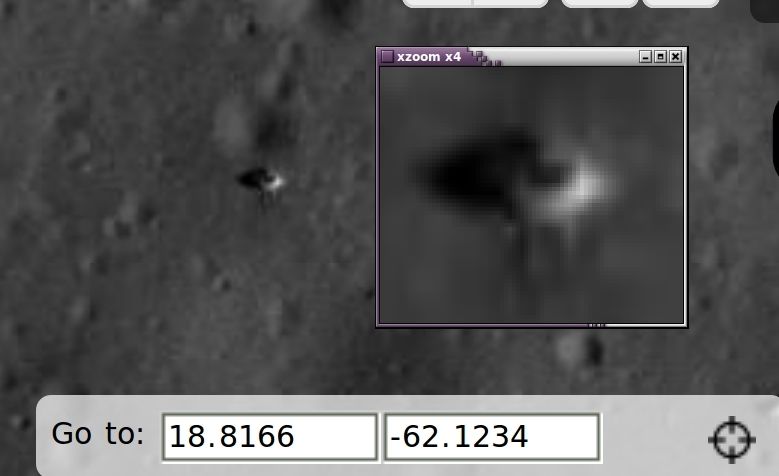
Posted by: Geert May 4 2013, 10:01 AM
Definitely interesting and close to the expected position of Luna 13, but I wonder about the size, it seems to me somewhat too big. Remember the E6 landers were just 58 centimeters in diameter, and although the outfolded pedals make it slightly bigger that's still only very close to the maximum resolution of the LRO camera, in other words they won't be more then a few pixels at most and this object seems a lot larger.
It clearly casts a shadow, so that might help also, if you know the sun-angle at the time the picture was taken, you can use that to calculate an estimate of the height of the object, see if this confirms with the E6 landers.
And, finally, if this is Luna 13, you should be able to find more objects in the vicinity. The cruise-stage landed at very low speed and should have come down more or less intact in the vicinity of the lander (in fact, the cruise stage was considerably larger then the lander, you might find the cruise stage first, and then the lander, or the object you have found might be the cruise stage). On the panorama pictures from Luna 13 you can see some objects on the surface, and some of them seem to be part of the spacecraft itself, see if they match with your observation!
Luna 13 is definitely making a chance to be found, I would guess. We know it landed on a relatively flat, featureless, plane with not many big stones or suchlike lying around, so provided there are sufficient shadows it should stand out. The small size of these landers is however what makes it so hard, they were really small and close to the limits of the LRO camera system.
Posted by: jasonjason May 4 2013, 11:37 AM
Thanks for the input Geert,
I do have the NACS with the object and there is anothe object close by I will post them. Can you explain calculating sun angle to get size? I find it hard to measure using the measuring tool in ACT-REACT.
Posted by: jasonjason May 4 2013, 11:53 AM
Here are the NAC strips with the object.
I have already shown this object to Phil and he does not think that it is Luna 13, I agree but I can't get it out of my head that it is something man made, maybe an unknown probe no one said anything about.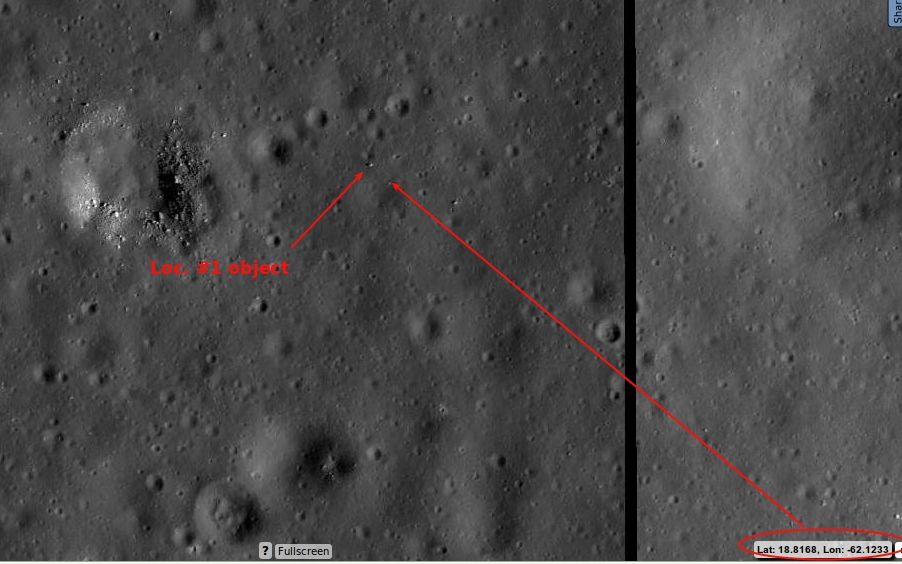

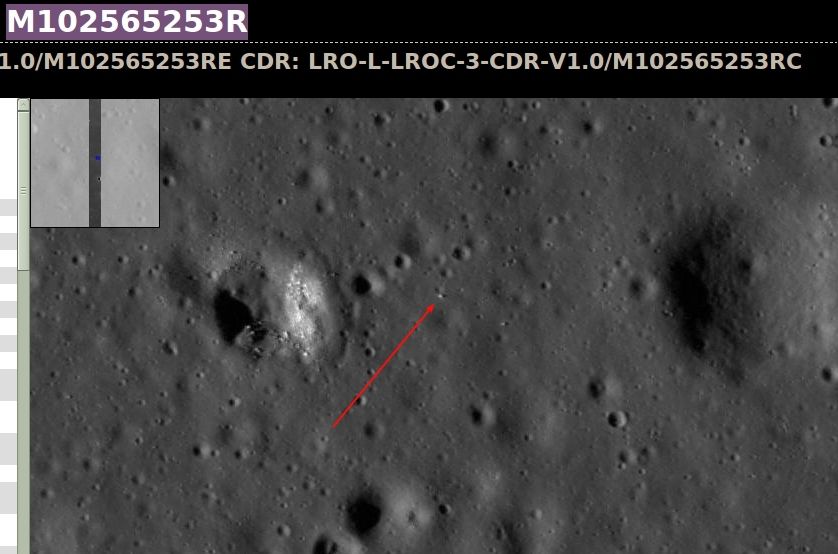
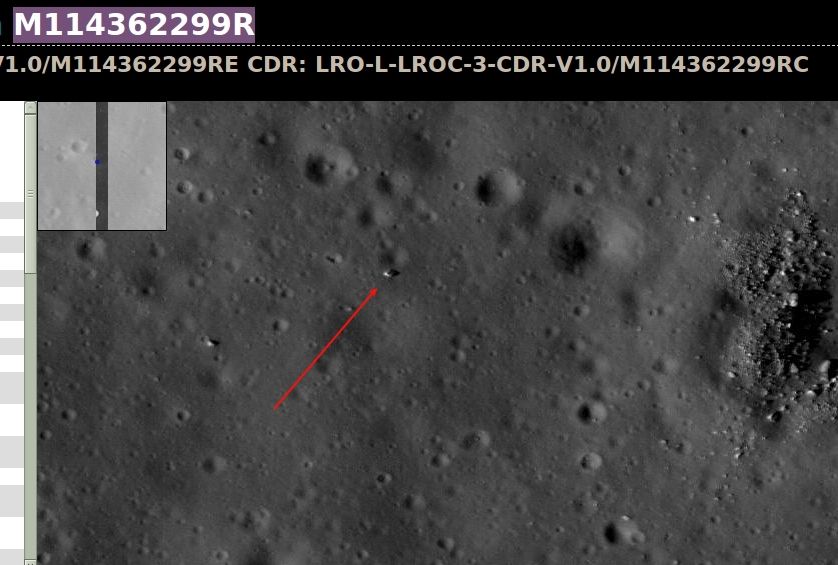
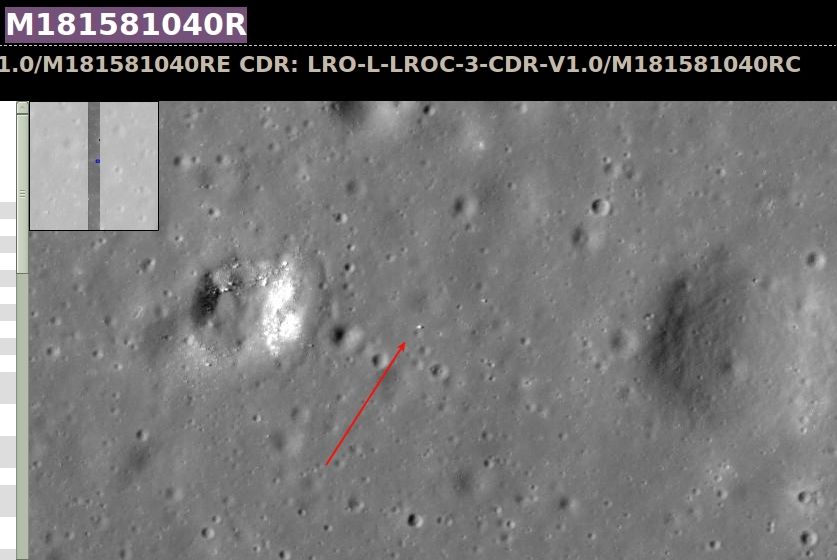
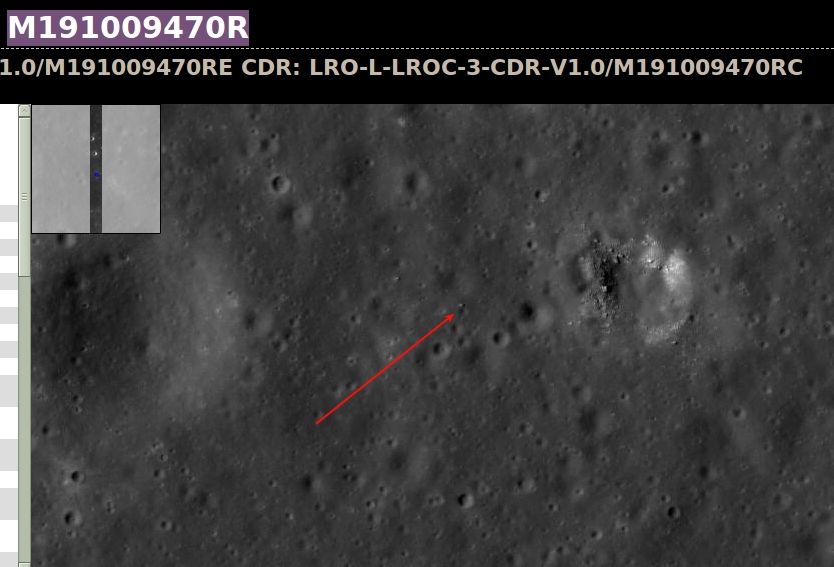
Posted by: Phil Stooke May 4 2013, 01:18 PM
This is a very interesting object, but of course there is no other lander in the vicinity and the features around it do not match the pattern of craters imaged by Luna 13 (since they cover a much larger area than Luna 13 itself, they are going to be the deciding factor). So it has to be just a rock, but a very interesting rock. Note that the two lines extending from it are probably artifacts of the compression algorithm.
Posted by: tolis May 4 2013, 05:51 PM
Apart from the successful Luna 9 & 13, Lunas 7 and 8 also reached that part of the Moon, impacting
at high speed. According to NSSDC, Luna 7 impacted at 9.8 N, 47.8 W, while Luna 8 impacted
at 9.1 N, 63.3 W. Impact speed would have been up to ~3 km/s, perhaps lower for Luna 8 if you believe one story
that the retrorockets fired late. On the premise that metal does not completely vapourise under these conditions, there should
be a couple of interesting debris-littered craters somewhere in the W part of the Ocean of storms.
Tolis.
Posted by: Phil Stooke May 4 2013, 10:23 PM
This is an image I sent to Jason which shows more what I would be looking for at the Luna 13 location. The arrow points to a small lump inside a crater which also contains another crater - the pattern of features imaged by Luna 13 according to the map drawn by Soviet scientists at the time. Looking towards the horizon the images suggest a very subdued larger crater north of the lander. So the general pattern seen here should be roughly what we would expect. This one is not quite right - some other small features nearby don't show up as I would expect. But it's pretty close. (we might also expect a bright blast pattern around the lander caused by its braking stage - as well as the stage itself crashed nearby)
Phil
Posted by: Phil Stooke Oct 16 2013, 02:09 AM
This is the Surveyor 1 site imaged by LROC - the image number is in the file name if you save it. I have indicated the Surveyor itself. Northwest of it is a small dark spot, which by analogy with the similar feature at Surveyor 3 I think might be the retro-rocket impact site. At Surveyor 3 there was a pre-landing Lunar Orbiter image to confirm that the spot was a new feature. Here there is not - Surveyor 1 landed before Lunar Orbiter 1 was launched. So I can't be certain, but it's a reasonable match to what I would expect.
Phil
Posted by: kenny Jan 29 2014, 10:09 AM
I've just noticed this interesting post. This suspected motor is displaced northwards of the landing site, just like the Surveyor 3 suspected one, albeit Surveyor 1's has a big westward component.
(Assuming north is up, which I think it is.) I recall that we searched the Apollo 12 surface photos looking out in that direction, with no result. Alan Bean confirmed to me that they never went up to that area,
and had no opinion on that being the descent motor. I'm trying to find out if there was any expected consistency in the displacement of these motors from the lander after release.
Posted by: Paolo Jan 29 2014, 09:05 PM
not a landing site but... LRO has imaged LADEE zooming by!
http://lroc.sese.asu.edu/news/index.php?/archives/857-Close-Encounter!.html
Posted by: Tom Dahl Jan 30 2014, 03:07 PM
RE: LRO imaging LADEE -- amazing! Reading the article linked by Paolo reminds me how clever and how capable are the folks who create these spacecraft and operate them.
Posted by: Hungry4info Jan 30 2014, 07:35 PM
That's immensely impressive that they were able to resolve structures on LADEE. ![]()
Posted by: charborob Mar 4 2014, 06:18 PM
New LROC http://lroc.sese.asu.edu/news/index.php?/archives/869-Still-There!.html of Chang-e 3's landing site.
Posted by: Phil Stooke Mar 4 2014, 07:31 PM
Excellent! Looking carefully at a blow-up of the GIF sequence, it looks like there might have been a very small movement backwards on day 3. Still trying to decide iif it's real or an effect of the different lighting. EDIT - no, there's no movement at all when perfectly registered...
Phil
Posted by: Phil Stooke Jul 24 2015, 10:49 PM
Here are two LROC images of lunar hardware... possible identifications of the retrorockets of Surveyors 5 and 6.
Each Surveyor was slowed during its approach to the surface by a rocket mounted underneath the lander. It and its fuel tank were ejected a little way above the surface and fell to the surface at relatively low velocity. The lander continued to the surface supported by three small 'vernier' thrusters (except Surveyor 4 which failed at the point of rocket separation... Surveyor 2 failed much earlier in its flight).
Can the retro-rockets be identified in LRO images? I previously put up an image of Surveyor 3's retrorocket, which is not in doubt as a correct identification because we have pre-landing Lunar Orbiter images, and a dark spot in LRO images is not present in the old images.
A few posts up in the thread I suggested a possible candidate for Surveyor 1's retrorocket. It's not certain but it's possible. Here I show images for Surveyors 5 and 6. I use the highest sun image to look for dark spots. In each case there is only one good candidate. And each one has a short trail of dark spots leading to (or from) it as if the tank rolled or bounced a bit. I don't know if the dark spot is the impact point or the hardware itself, i.e. I don't know which way the object moved along that possible trail of spots. Surveyor 3's candidate has the same trail of spots. Therefore, I think these are very promising identifications.
Surveyor 7 is never seen with sun near the zenith and I have not yet found a candidate rocket. Surveyor 1 doesn't have a very good high sun image either, and I'm not so convinced that my suggestion is correct.
Phil
Posted by: dvandorn Jul 25 2015, 12:50 AM
Looks like Surveyor V's retro-rocket (if you have it correctly identified, and I think you do, Phil) might have rolled a distance before it came to rest. They weren't coming in fast enough to dig deep craters, so I guess it doesn't surprise me that one might roll a bit.
Since at these high-sun conditions the topography becomes completely washed out, it's hard to tell if maybe V's retro might not have rolled down into a shallow crater. As it's darned near impossible to get the original TIFFs from the LROC website anymore, I don't have the best way to go looking for lower-sun images of the site to check for such a shallow crater. Could you take a look and see if my theory holds any water, here, Phil?
Oh -- I looked upthread, all the way to where I began the thread more than five years ago, and I didn't see any posts of the likely Surveyor III retro's final resting place, even though I know I've looked myself and have suspected a suspicious object to the north of the landing site. Could you point me to where you posted your identification? I'd like to look at it myself (assuming I haven't already -- age plus the heavy painkillers for so many months before and after these darned surgeries have not done good things for my memory, it seems).
-the other Doug
Posted by: Phil Stooke Jul 25 2015, 02:04 AM
It was in the Apollo sites thread:
http://www.unmannedspaceflight.com/index.php?showtopic=6111&st=285
Phil
Posted by: dvandorn Jul 25 2015, 03:07 AM
Thanks, Phil! Yeah, that was the thing I saw in the early LROC images of the Surveyor III site that I thought might be the retro. Somehow, I don't recall seeing that thread -- and that's unusual for me. Again, I plead painkillers... ![]()
I agree that it's going to be way easier to find hardware on the Moon in the LROC images taken at very high sun angles than the low sun angle images, and I must say you've been having great success at it. It's great to see every new little bit of hardware we've left up there, and you more than most have been the best at finding things. It's a privilege to watch.
But in some cases, after finding the stuff, it also seems to me that it can inform the "dark blob" images if you know if there are, say, local slopes or other landforms that act to modify the piece of hardware's "look," and that aren't very obvious under a high sun. The kind of stuff you would see much better at lower sun angles. So, just sort of thinking, if after finding things, do you also look at them at lower sun angles, too? Are they usually available at the same resolution at lower sun angles?
Or is it something of a crapshoot, even now?
-the other Doug
Posted by: Phil Stooke Jul 25 2015, 05:30 AM
Doug, usually there is very little to see in the low sun views at those locations.
The site you crave with every fibre of your being is this one:
http://lroc.sese.asu.edu/featured_sites
For this purpose you can go to the Surveyor link, and for each Surveyor you can view individual images, and flip-books which let you scan from morning to evening illumination. And there are lots of other sites to look at as well.
I've looked at pretty much every one of these images now.
Phil
Posted by: Phil Stooke Sep 3 2015, 07:09 PM
A follow-up on Surveyor 3.
At left, an LROC image (M175428601R). At right, part of Lunar Orbiter 3 frame 154H2, taken before the Surveyor 3 landing.
This is the first time I have seen the retro-rocket impact at low sun, and the dark spot discussed earlier is revealed to be a crater with a central lump - the fuel tank and/or other components sitting right there. The crater clearly does not exist in the Lunar Orbiter image despite the lower resolution.
Phil
Posted by: nprev Sep 4 2015, 04:33 AM
That's a really cool find! IIRC the impact velocity was fairly low; amazing that the hardware seemingly survived yet produced such a substantial crater.
Posted by: charborob Sep 4 2015, 10:38 AM
Phil, can you give an estimate of the size of that crater?
Posted by: Ian R Sep 4 2015, 01:02 PM
Wow! I wonder if this area was covered by Apollo CSM or Metric Camera photography?
Posted by: Phil Stooke Sep 4 2015, 02:14 PM
The crater is only about 2 m across. There are no Apollo images of the area at any useful resolution.
Phil
Posted by: dvandorn Sep 5 2015, 12:23 AM
Excellent find, Phil! That's exactly the kind of image I was looking for.
And, see -- once you locate hardware on the surface, the low sun images are actually helpful in characterizing them. The high-sun images would never have implied the amount of the retro-rocket that survived its final plunge intact.
-the other Doug
Posted by: Phil Stooke Sep 5 2015, 03:19 AM
I should say that that particular image is one of those taken from the very low orbit a few years ago before LRO moved into its current high orbit. It has a scale of 25 cm/pixel, twice as good as the best we have for any other Surveyor.
Phil
Posted by: Ian R Sep 29 2015, 09:29 PM
I have an exciting addendum to Phil's Surveyor 3 retro-rocket discovery, as detailed here:
http://www.planetary.org/blogs/guest-blogs/2015/0915-finding-the-surveyor-retro-rockets-on-the-moon.html
Last night, I came upon the candidate crater formed by the retro-rocket impact in the Apollo 12 descent film:
https://www.youtube.com/watch?v=NlgGveDiqW4
It first appears at 3:24, is best seen around the 3:39 mark, and goes out of frame at 3:51.
A frame culled from the 16-mm film (shot out of LMP Alan Bean's window), is shown below alongside a crop of the highest resolution LRO frame:
My thanks to Phil for confirming what I think is a rather interesting find: a man-made crater within walking distance of one of the Apollo landing sites!
Posted by: Phil Stooke Nov 27 2015, 09:43 PM
OK, it's time to prepare LPSC abstracts for next year. And what do you know, I was working on Surveyor retro-rocket images when I found that my Surveyor 6 suggestion above is wrong, and I found the real thing not far away.
This was the result of looking at Lunar Orbiter images from before the Surveyor 6 landing. LO2 frame 121-H3 reveals that the little spot I identified as the retro-rocket was there before the landing. But another one, the same distance from the lander (300 m) was NOT there before the landing. Eureka! Guess I should have done this earlier. (Unfortunately there are no pre-landing Lunar Orbiter images for Surveyor 1 or Surveyor 5)
Phil
Posted by: dvandorn Nov 28 2015, 01:23 AM
Oh, yeah -- it looks like you've definitely nailed it. If that's not the Surveyor VI retro-rocket, it's a very, very coincidental impact of exactly the right size, and in exactly the right place, that came from something else.
I still think the items with the highest cool factor would be to find the impact sites of Surveyors II and IV. I know that at least one of them is likely to be a small field of little craters, since it's likely that its solid-fuel retro exploded. But it would be really interesting to see the resulting impacts. (Doubtful they would be discernible, more's the pity...)
-the other Doug
Posted by: Phil Stooke Nov 30 2015, 01:56 AM
On a related note - not a landing site exactly - news of the Apollo 16 SIVB impact location on the Moon:
http://www.leonarddavid.com/found-impact-site-on-the-moon-of-apollo-16-rocket-stage/
The location was very uncertain. I don't have coordinates yet.
Phil
Posted by: Phil Stooke Dec 14 2015, 06:40 PM
From this link:
http://lroc.sese.asu.edu/posts/894
the coordinates are now available.
Phil
Posted by: Phil Stooke Dec 15 2015, 11:51 PM
And here is a locator image if you want to find it yourself.
Phil
Posted by: Phil Stooke Jun 22 2016, 08:15 PM
I have been experimenting with making improved images of Luna 17 and Lunokhod 1 for my revised moon atlas. These two images are each composites of eight LROC NAC images, enlarged and registered. The tracks are much more visible than in single images.
Phil
Luna 17
Lunokhod 1
Posted by: Phil Stooke Jul 26 2016, 09:24 PM
continuing the theme of improving LRO NAC images by combining several of them... here are two Surveyors:
Surveyor 1
Surveyor 3
Phil
Posted by: Phil Stooke Mar 27 2018, 11:55 PM
I had someone ask me about Surveyor 4 today, and the question comes up every now and then. Recently I tracked down a candidate for it, so here it is, with a bit of speculation.
What should we be looking for? There are three obvious suggestions arising from three possible fates for the spacecraft.
1. Successful landing, but power or communications fail. We would see a lander like the other Surveyors, a lump casting a shadow in low sun images, probably surrounded by a bright patch where the rocket exhaust changes the surface - we see that for most landers. Also, a few hundred meters away we might see a dark spot, possibly resolved as a small crater, where the retro-rocket hit the surface after it was ejected.
2. The retrorocket fails to separate and the small thrusters used for landing fail or can't cope with the extra weight. A crash, showing up as a dark spot or small crater, but no separate retro-rocket impact.
3. The retrorocket separates, but one or more thrusters fail to ignite. The lander falls to the surface, with a retro-rocket impact nearby.
What do we see? Here is a map showing the target and a zoom-in sequence leading to my candidate site:
And here is a comparison of the five LROC-NAC images we have now:
My candidate is a dark spot which, in the best images may be resolved into a small crater. No bright halo, no lump casting a shadow. If it is Surveyor 4, it crashed. South of it at a distance of 200 m is a small dark spot which might be the retro-rocket.
To me this suggests scenario 3.
Phil
Posted by: nprev Mar 28 2018, 12:22 AM
Looks compelling. Is it well within the intended landing ellipse? If there was a single thruster failure it may be offset from the projected course line.
Posted by: Phil Stooke Mar 28 2018, 02:11 AM
Well within the ellipse which was about 30 km across, and in fact only about 1500 m from the location suggested by tracking.
Phil
Posted by: nprev Mar 28 2018, 03:51 AM
Hmm. Sounds like a #2 splat is more probable, then. A #4 splat (total, near-simultaneous descent thruster system failure after retro jettison) might also explain it, esp. if they did fire for a bit but cut off prematurely, which would also explain the apparently very good targeting.
Posted by: Explorer1 Mar 28 2018, 12:32 PM
It would be so cool if some of those private company landings (Lunar Express, etc.) launching soon were targeted to this location to get the ground truth. Since they aren't scientific missions, they could play a part in solving some of these space age mysteries. It's a crash site already, so it's not like landing at the Apollo sites, which raises heritage issues...plus practicing precision landings is always a useful exercise!
Posted by: Phil Stooke Mar 30 2018, 02:30 PM
There are probably more interesting targets! And remember this is only a suggestion, it might not be correct. A bigger splat like a Saturn SIVB stage impact might be more exciting to look at close up. Right now, though, most of the people who want to fly commercial missions are looking at doing science rather than just sightseeing. PTScientists are looking at landing in the Taurus-Littrow valley and inspecting the Apollo 17 rover, but other post-GLXP teams are focussed on science, hoping for a boost for future missions if they can demonstrate their technology works.
Phil
Posted by: jccwrt Mar 30 2018, 05:29 PM
You could make the argument that these splats are worth scientific investigation, because they're likely to expose blocks of "fresher" rock from within the regolith or even solid crust (depending on penetration depth and what not). They're not in-situ, but you're also able to get a look at larger samples without having to grind away on them to get a fresh surface.
Posted by: PDP8E Mar 31 2018, 08:46 PM
I saw your post on Surveyor 4 and dug up my old candidate files...
These are NAC images with illumination from West, Small incident, East , and Terminator (west)
The Object is at 0.407N, -1.3493W
It is probably a rock (sigh)
I forget how much I blew them up, but they are all the same scale (3x?)
anyway it's a nice little shadow casting object near the landing point...
here is a GIF ...
Posted by: kenny Dec 8 2019, 11:37 AM
Going back a little, to the chat about LM impact images (and Post #384 by dvandorn about seismic detection)... they all came in at low incidence angles, quite unlike the SIVBs, hence the "smear" effect of tumbling debris in multiple dark streaks. Might this not produce a quite different seismic result than direct impacts from the virtually overhead descent of the SIVBs?
Posted by: Liss Feb 26 2020, 07:54 PM
I’d like a possibility to be checked that I’ve found Luna 9 in LRO images.
Expected:
Two objects of different size, namely E6 descent stage and the Luna 9 probe, landed in the vicinity of 7.13 N 64.37 W according to the TASS report of 06 Feb 1966.
Found:
Two bright objects of different brightness, with long shadows, 130 meters apart, at approximately 7.02 N 64.33 W.
Positions:
M132071202LE
Larger one – Line=23370, Sample=1379
Smaller one – Line=23220, Sample=1645
See attached fragment (N at bottom, E at left)
M114376090RE
Larger one – Line=27910, Sample=3828
Smaller one – Line=28056, Sample=4073
M132071202LE
Smaller one – Line=23660, Sample=275
Larger one – off picture but a black scar (?) seen at L=23706, S=66
Cross-posted in Russian at http://novosti-kosmonavtiki.ru/forum/forum11/topic1255/?PAGEN_1=91
Posted by: Phil Stooke Feb 27 2020, 01:02 AM
It's always interesting to see attempts to find one of the early Luna landers.
In this case, first, can you show with arrows which objects you think are the lander and the descent stage? There is one particularly large object but there are at least two smaller ones. (ADDED later: OK, I see you did that in the post on the Russian forum).
Second, the coordinates given at the time were not very reliable, with an uncertainty of about 30 km (1 degree on the Moon). The landing should be in an area within about 30 km of the stated position, not necessarily right there.
Third point - we don't have to rely only on looking for objects on the surface. Luna 9 took images which include a full 360 degree panorama showing about 200 degrees of the horizon (south, west and north of the lander). That horizon is flat, a point which I have argued for years to imply that the lander is not where the early reports said, near a range of 1000 m high hills, but must be far enough away that the hills are hidden below the local horizon. That local horizon could be a gentle ridge or degraded crater rim, so we can't just use the geometry of a featureless spherical moon to calculate a distance from the suggested point. Your coordinates are at the east end of the range of hills, and the western horizon from that location would not be flat. I personally prefer to look further north, maybe about 7.9 north, 64.2 west. But there is room for a lot of variation in those values.
And since we have images, a rough map of the landing site can be made and the pattern of craters can be compared with the LRO images. Now what we need is an object representing the lander, an object representing the descent stage, AND several craters with sizes and positions matching the lander images.
I will compare lander images and your LRO image in a later post. I do believe the search can be made successfully, but I don't think your identification is correct. I actually think Luna 13 will be easier to find than Luna 9 because the features seen in the distant landscape are clearer. For Luna 9 the distant landscape is down-sun and all washed out.
Phil
Posted by: Phil Stooke Feb 27 2020, 01:54 AM
OK, here is a comparison of the suggested features with two versions of maps of the site.
1. The LRO image (rotated north-up) with two identified features, from the link in the previous post.
2. Shaded relief version (by me) of the original Soviet published map (from 'First Panoramas of the Lunar Surface').
3. A different interpretation of surface features, by me, derived from a reprojected panorama.
The differences between the two maps from Luna 9 images show how difficult it is to map the surface from a camera at such a low elevation above the surface.
I don't see any obvious matches.
Since we don't see the descent stage in the lander images, most likely it is east of the lander (or northeast or southeast), excluded from the tilted panorama. It might also lie west of the lander in an area in the foreground which was also not imaged.
Phil
Posted by: Liss Feb 27 2020, 12:06 PM
I don't see any obvious matches.
Thank you Phil.
The Luna 9 maps show area some 15 meters in diameter; I'm not sure if these can be matched against LRO photos.
A 1967 description of Luna 9 say it rests in the western slope of a depression of 14-15 meters in diameter, hence the tilt to the east. Such a depression should probably have been visible.
Also, we should expect two fresh craters in the vicinity where two equipment sections crashed after separation at descent brake start.
Posted by: Shan Oct 31 2020, 06:06 PM
May be this is the elusive Luna9 we are looking for? There is small mark from NorthWest (25m from where it would have landed & rolled off?)
- The crater to the right is 6m in length
Landed near to a crater with diameter of 210-360m ( North of the landing spot there is a crater with length of 360m)
There is a SouthWest small Hill feature at a distance of 7.5 km(Not sure whether it will be visible)
LRO Images are from 0.44,0.52m resolutions
To the Southern Side is the feature next to Plantia Descencus (The height of is 600m & I am not sure whether they would be visible from a distance of 7.5km due to Moon's curvature)
Posted by: Phil Stooke Oct 31 2020, 06:31 PM
That's quite a good match to nearby features, better than what I usually see. I have highlighted one object which I think should be very apparent in the images but is missing. I feel that the feature in the area of my 'crater E' should be more prominent.
I don't mean to be eternally negative, but this is a very difficult problem to solve and only the most convincing evidence is good enough.
It would be useful to know where this is. The issue of the mountains near the usually reported position has to be addressed. Shan had previously suggested a location in the hills south of the usual position but I didn't like the topography nearby which I felt would not allow a flat horizon to the south and west.
Phil
Posted by: Shan Nov 1 2020, 05:13 AM
I don't mean to be eternally negative, but this is a very difficult problem to solve and only the most convincing evidence is good enough.
It would be useful to know where this is. The issue of the mountains near the usually reported position has to be addressed. Shan had previously suggested a location in the hills south of the usual position but I didn't like the topography nearby which I felt would not allow a flat horizon to the south and west.
Phil
Sent you the co-ordinates in a message with links
Yes there is something visible as you said see the below images and One is the normalized without any zoom & another one is a zoomed in picture.. And also attached a Gif of the same area under different lighting conditions & the object lighting remains almost the same with darkness underneath due to soil disturbance?
There are some debris to the South East side but I don't see any craters ( The images I have attached here are 0.44m resolution)
Posted by: Shan Nov 4 2020, 01:56 AM
Yes there is something visible as you said see the below images and One is the normalized without any zoom & another one is a zoomed in picture.. And also attached a Gif of the same area under different lighting conditions & the object lighting remains almost the same with darkness underneath due to soil disturbance?
There are some debris to the South East side but I don't see any craters ( The images I have attached here are 0.44m resolution)
The only thing I doubt is all the reports mention it should be on the western slope of a small depression so the tilt to east
Lat:7.506
Lon:295.508
https://quickmap.lroc.asu.edu/query?extent=-64.5058613,7.5012244,-64.4811278,7.5127337&proj=16&features=-64.39470547,7.20609986,-64.39482419,7.20546668,-64.39359741,7.20528201,-64.39372932,7.20580965,-64.39470547,7.20609986|-64.45076361,7.40145216,-64.45053936,7.40060792|-64.48468864,7.45556779,-64.48504480,7.45468399,-64.48376526,7.45447293,-64.48348825,7.45538312,-64.48468864,7.45556779|-64.49235301,7.50655143,-64.49245854,7.50569401,-64.49150877,7.50569401,-64.49119218,7.50664377,-64.49235301,7.50655143&selected=3&query=99&layers=NrBsFYBoAYchGSJQBYF0QOwK4BteQDeAvgLqlFmlA
Is the Western slope means the slope is from east to west? and the place where I am exactly showing is 2m below the surface
Posted by: Phil Stooke Nov 4 2020, 04:03 AM
The lander is tilted so that its top is pointing towards the east. The image strip is looking down at the foreground on the east and up into the sky on the west - just catching he horizon at the bottom of the panorama. The trouble is, we don't know if that means it is sitting on a small rock or a crater wall. If it's a crater wall it is on the western inner wall of the crater so it faces towards the east - but there is no evidence in the image to say that is what it has to be. It could be on a small rock on otherwise level ground.
Your location is not very far from the hills to the south, and I think they should be visible in the southern part of the panorama. I would feel more comfortable being another 10 km north to get those hills below the horizon. The Soviet coordinates came with a big uncertainty, plus or minus about 15 km. An exact distance from a hill of any given height is difficult to state because the horizon could be formed by a local rise, not an ideal horizon on a smooth sphere.
The crash stage - the discarded landing rocket - should be visible nearby as well, substantially larger than the lander and probably mostly intact as it was also travelling at low speed.
Posted by: Shan Nov 26 2020, 11:06 AM
Your location is not very far from the hills to the south, and I think they should be visible in the southern part of the panorama. I would feel more comfortable being another 10 km north to get those hills below the horizon. The Soviet coordinates came with a big uncertainty, plus or minus about 15 km. An exact distance from a hill of any given height is difficult to state because the horizon could be formed by a local rise, not an ideal horizon on a smooth sphere.
The crash stage - the discarded landing rocket - should be visible nearby as well, substantially larger than the lander and probably mostly intact as it was also travelling at low speed.
I believe the previous picture might not be the luna9 landing site as the craters surrounding it are too large (They are nearly 10m in Size whereas from your pictures its supposed to be less than 1m or 2m in diameter)
And the most important thing I found out is the landing location of Luna13 is 440km from Luna9 (from Soviet sources & papers). If you calculate the distance between Luna9 (7.13, 295.63) and Luna13 (18.87, 297.95)..it comes to around only 390 kms.. so Luna9 might be have landed South of the intended landing site (If we find Luna 13 then we must be able to find Luna 9 sooner)
Posted by: JRehling Nov 26 2020, 07:33 PM
The process here reminds me to a fair extent of what I go through when I take pictures of a star field trying to locate a point object, such as a comet, quasar, dim star, or Pluto. Pluto is invariably surrounded by many brighter stars and so I must compare the stars in my image to the finder image. This is in principle not a challenge because a match always exists and can always be found, but in practice – an imperfect mount alignment combined with the time pressure of making sure my telescope is aligned in time to take longer-exposure images – it can turn into 30 minutes of high stress and I find myself doing almost exactly what you are doing in this thread here.
So I wonder about an algorithmic approach to solving this problem.
Of course, one big difference is that sky field images consist, essentially, of points of varying brightness, with pure black between them. The lunar map analog would be craters, and that's a strong but imperfect analog, with other variations in topography being part of the reality and hard to abstract into something that an algorithm would represent and handle well.
If there are enough outstanding mysteries to solve, it might be worth pursuing an algorithm to facilitate the process. Our eyes are wonderful at identifying patterns of many kinds, but aligning maps of star fields or of craters is not one of them.
Posted by: fredk Nov 26 2020, 08:13 PM
I guess you're talking about https://en.wikipedia.org/wiki/Astrometric_solving - the process of automatically matching a star field image to a map. I could imagine applying plate solving software to matching a projected local lunar panorama to maps. Someone would need to identify craters and create an effective "star map", with the position of each "star" representing the crater location and the brightness of each "star" representing its size. Plate solvers incorporate tolerances that could take into account errors in the panorama due to topography etc. But that would be a huge amount of work unless it could be automated somehow.
Otherwise some more generic image matching might work, if maps and panoramas had similar lighting?
Posted by: Phil Stooke Nov 26 2020, 09:40 PM
This problem is not really suitable for the kind of algorithm being suggested here. A problem that would be suitable would be trying to match a descent image taken by Chang'e 5 with an LRO image to locate the landing area. That's two overhead views. With Luna 9 we are looking at a very low angle oblique image (the camera was about 50 cm above the surface) and a restricted area of good coverage (looking down-sun there are no visible details, looking up-sun we are only seeing an area about 2 or 3 m wide as the camera was tilted down in that direction) and everywhere the image contains bad relief distortions. My reprojected Curiosity panoramas are much more amenable to comparison with a HiRISE image because of the higher viewpoint and 360 degree coverage, but even there we are helped by knowing pretty closely where to look (and I have made bad mistakes sometimes). For Luna 9 we could be looking anywhere within a circle 30 km in diameter (maybe a bit more).
Eventually it will be found. The LRO image will show the lander, the landing stage, maybe the air bag pieces, a brightened blast zone around the landing stage site, and several craters and rocks recognizable in the panorama. When it's found it will be immediately obvious, but until then we will just have rocks and craters in some vague semblance of the expected pattern.
I think Luna 13 will be easier to find because of a better view of middle distance features.
Phil
Posted by: Shan Feb 9 2021, 01:32 AM
I believe Luna9 will be easier to find as the hill that is visible on the image might be the one that is to the east of Planitia Descensus and searching in and around the area found something like these.. but need to see what exactly they are those.. They might be the debris as they nearly match the distance the hills can be seen from the pics..
Posted by: Shan Jul 28 2021, 06:28 PM
Eventually it will be found. The LRO image will show the lander, the landing stage, maybe the air bag pieces, a brightened blast zone around the landing stage site, and several craters and rocks recognizable in the panorama. When it's found it will be immediately obvious, but until then we will just have rocks and craters in some vague semblance of the expected pattern.
I think Luna 13 will be easier to find because of a better view of middle distance features.
Phil
Phil whether the rocket stage impact of Luna9 would look similar to this? Not sure but this one has a diameter of 5~8m & irregular in shape (Whether a mass of 1400kg hitting at 22 km/hr would make such a impact?)..
Posted by: Phil Stooke Jul 29 2021, 04:18 AM
I think if an object hits the surface at 22 km/h it would be damaged but it would still remain largely intact and would show up in the images as a single object. It would be similar to a large rock in appearance. it would probably not look like this, a crater with rays. To me this looks like a natural crater formed by a high speed impact. If it was the Luna 9 braking rocket stage the lander would be close to it and the pattern of craters visible around the lander in the panorama should be visible as well.
Phil
Posted by: Shan Jul 29 2021, 08:29 AM
Phil
Not sure my 22 km/hr estimate was right because from here - https://nssdc.gsfc.nasa.gov/nmc/spacecraft/display.action?id=1966-006A.The article says that capsule impacted at 22 km/hr and didn't mention anything about the rocket stage.
https://nssdc.gsfc.nasa.gov/nmc/spacecraft/display.action?id=1965-044A - Luna8 one..
- At 48 seconds before the capsule velocity was at 9300 km/hr (2.6 km/s)
- Then main engine fired for 48 seconds from 75km to 250m
- At 250m 4 vernier engines with a thrust of 245N fires and slows down the vehicle further (A probe is released from the bottom of the spacecraft to measure the altitude)
- When probe makes contact with the ground..the capsule is ejected from top of the spacecraft (Whether it's the same one that has a lander or a different one)
- After the capsule was ejected it impacted at 22km/hr & then bounced off several times
Whether it would be possible to have the velocity reduced from 9300 km/hr to 22km/hr under 50 seconds by 45000N Engine from 75km altitude to 250m? I am not sure about the exact details but there might be more to it as the details when the probe was ejected are still a mystery..Luna8 page on NASA says a boom was released from the bottom of the spacecraft to check the altitude but the pnot sure whether Luna9 capsule was ejected when the spacecraft was hovering? and after ejection it seems the 4 Vernier engines were cut off which might have resulted in spacecraft crashing on to the surface. The only way to verify this is to look for an impact similar to this near Luna13.. (Wish we had more details)
Location : https://quickmap.lroc.asu.edu/query?extent=-64.748724,7.3661521,-64.7239245,7.3787992&proj=16&features=-64.73668041,7.37233549&selected=0&layers=NrBsFYBoAZIRnpEBmZcAsjYIHYFcAbAyAbwF8BdC0yioA (Lat: 7.37233 Lon: 295.26334) - The small crater is about 4~5m in size..This might be even Luna8
if this is Luna9 rocket stage impact then Luna9 might be lying to North west of the impact point and the area also has depression from West to East..
Posted by: Shan Oct 16 2021, 03:09 AM
@Phil - Luna9 might have landed to further east of
From 3D model of the area, I believe the hill we are seeing SW at 240 degrees is the one to the left of Planitia Descensus. Luna9 might have landed between 7.20-7.50N and 296-297E (It might have been possibly inside the crater or an area that obscured Planitia Descensus with the hill to the right of Planitia Descensus being visible)
http://target.lroc.asu.edu/qm3d/o2w_3d_815394636_10_0_100_101_0/
Posted by: Shan Jan 24 2022, 08:57 AM
@Phil
Whether this could be one of the Luna9's Debris? Are we looking for something similar to this?
The 2nd picture is comparison of 3 different LRO images side by side
Posted by: Phil Stooke Jan 24 2022, 09:50 PM
It is a nice candidate. The landing stage should be visible somewhere nearby, and could possibly be the object in a small crater WNW of the 'lander' object, and larger than the lander. I would be happier if the crater SE of the lander in the panorama was more visible here, and if the area around the putative landing stage was brighter. So far, though, I would say this is the best candidate I have seen.
Can you show us where this is?
Phil
Posted by: Shan Jan 25 2022, 12:59 AM
Can you show us where this is?
Phil
Here is the location - https://quickmap.lroc.asu.edu/layers?extent=-63.0829917,7.4129112,-63.0582583,7.4252119&proj=16&features=-63.06545667,7.41887249&layers=NrBsFYBoAZIRnpEBmZcAsjYIHYFcAbAyAbwF8BdC0ypOOKbREONLRfImq7ioA
Lat:7.42075
Long:296.93447
I am not sure exactly whether this is the landing stage or we are looking at Luna9 itself. There are objects to NorthWest and SouthWest of this region looking liking debris but it's hard to tell..Will search more on the surrounding area..
Posted by: Explorer1 Jan 25 2022, 02:48 AM
Probably the best thread to post this (mods, please move if the LROC thread is better) It appears that DSCOVR'S second stage will be impacting the moon in a little over a month (far side):
https://www.projectpluto.com/temp/dscovr.htm
The chances of witnessing the impact by orbiters is tough, but a very fresh crater should have some scientific value (and the first ever unintentional impact, at least that has been precisely calculated).
Posted by: Phil Stooke Jan 25 2022, 08:15 AM
Thanks for pointing that out! Another point on the map.
Phil
Posted by: Phil Stooke Jan 26 2022, 07:33 AM
Shan, that location is quite far east of where we might expect Luna 9 to be. I think the Soviet idea of uncertainty for this site was about 30 km and this would be right on the outer edge of that or even a bit beyond it. It's not impossible but I would be happier if it was further west.
Phil
Posted by: Shan Jan 26 2022, 01:14 PM
Phil
Phil, These might be the side modules which got jettisoned before landing and also there is another similar rocket plume marks to the North East of the region (Both got jettisoned about 74km from the surface)
https://quickmap.lroc.asu.edu/query?extent=-63.0637566,7.4421591,-63.0390232,7.4539322&proj=16&features=-63.05025488,7.44830715,-63.06527718,7.42109762&layers=NrBsFYBoAZIRnpEBmZcAsjYIHYFcAbAyAbwF8BdC0yioA
I believe it's somewhere to the east of the region but need to look into those.. or in that area itself..as that hill would be still visible from that area, but I need to keep looking into it..
Posted by: Explorer1 Feb 4 2022, 08:35 PM
Some more estimates in this article, including a map of dispersions: https://www.space.com/spacex-falcon-9-moon-crash-one-month-away
North of Mare Orientale, so still a chance of impact on on the near side, depending on the solar pressure, other noise (and also lunar libration).
Posted by: Phil Stooke Feb 13 2022, 07:38 AM
Unexpected turn of events... it's not the DSCOVR upper stage, it belongs to the Chinese Chang'e 5-T1 mission launched slightly earlier than DSCOVR.
https://arstechnica.com/science/2022/02/actually-a-falcon-9-rocket-is-not-going-to-hit-the-moon/
Don't worry, we still get a crash!
Phil
Posted by: Explorer1 Feb 13 2022, 05:14 PM
Fascinating... I wonder where DSCOVR s upper stage went, then!
How different are the empty masses of the upper stages, for comparison, since the crater produced might be a bit different too?
Posted by: Shan Aug 20 2022, 09:10 AM
Phil,
Whether this could be Surveyor4's retro rocket impact site? Location: 0.3870, 358.70
The landing target was estimated to be 0.43 N, 1.62 W (or 0.37 N, 1.55 W) for a soft landing and 0.47 N, 1.44 W (or 0.469 N, 1.086 W) for a ballistic crash (From the below link, is it possible it would have crashed 0.3870, 358.70)
https://nssdc.gsfc.nasa.gov/nmc/spacecraft/display.action?id=1967-068A
Surveyor4 Impact : https://quickmap.lroc.asu.edu/layers?extent=-1.3080874,0.3788067,-1.283354,0.3911075&proj=16&layers=NrBsFYBoAZIRnpEBmZcAsjYIHYFcAbAyAbwF8BdC0ypcOKbRFaaKBJ-ImqnpOBjEQIQcZE06Fi5XjP7QAnOlAJViLtIBEeAE4FNALk0ALAC6mADgGcDAelsBHALYBaCzoD2ADwCeAOgJPAGM-AEMrPD8AUwATPFsAMyCAcwBLFwAjVJxE9w8ANwB3KIzoryiAfgJQnyidAF5AjyCcUKCAMg9UmPqAJmg4aABSXoAxaAAOBRHRgFk4XvRwAHYFcWWAJXaAL3rodq899p8joKcYgH0rIJ1Ui1N65KjTC9NUgii-JytjTUhNUw+CxRQyaHThUx1P6aaoZKL6IzzRYrNbQTYAYWhrScIMRCyWq3WG0xlAoQA&title=Surveyor4%20Impactnull
Posted by: Phil Stooke Aug 21 2022, 07:13 AM
Hi Shan. Give me a few days to consider this. It's certainly possible but there are other dark spots in the area.
Phil
Posted by: Phil Stooke Sep 12 2022, 11:53 PM
OK, I have been pondering this. Ponder, ponder - there, I just did it again.
Here is my guess for Surveyor 4:
This shows the Surveyor 4 target as it evolved from before launch to after launch (when they had a better idea of the trajectory and could shrink the landing ellipse) and where tracking suggested it actually went. The failure came at or just before the end of the retro burn, which did most of the job of bringing it to the surface, so it should be fairly close to the tracking location.
The site I zero in on shows two little dark spots. When you start looking at the high sun LROC NAC images there are a surprising number of little dark spots and it is not at all easy to decide which to pick. My rationale is that the retro burn was probably completed and the failure occurred when the small vernier thrusters took over from the retro system. Therefore I assume the retro engine fell to the ground as expected rather than exploding into fragments. So I was looking for a place where there were two dark spots, one for the lander and one for the retro rocket system. The one I found has two spots about 200 m apart, which is roughly what we see for the two where we know we have it right from before/after images (Surveyor 3, Surveyor 6). But other searches might find different candidates.
Shan's point is close to the target but quite a long way from the tracking location. So I still prefer mine for the time being. But I will change my mind if someone finds a better candidate.
Phil
Powered by Invision Power Board (http://www.invisionboard.com)
© Invision Power Services (http://www.invisionpower.com)

